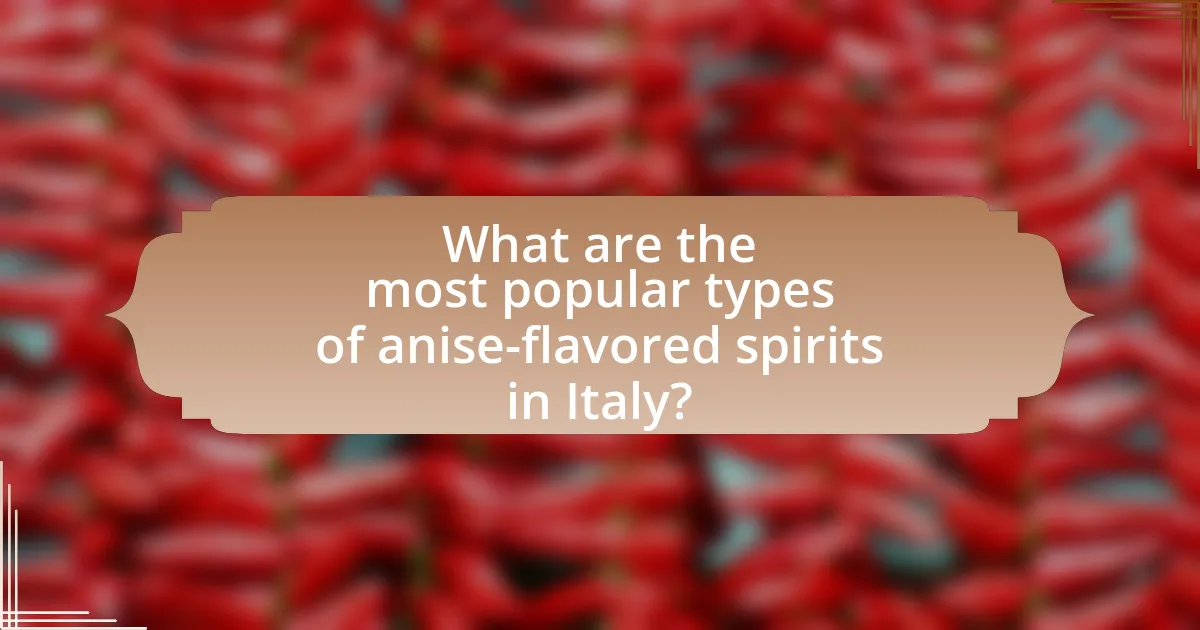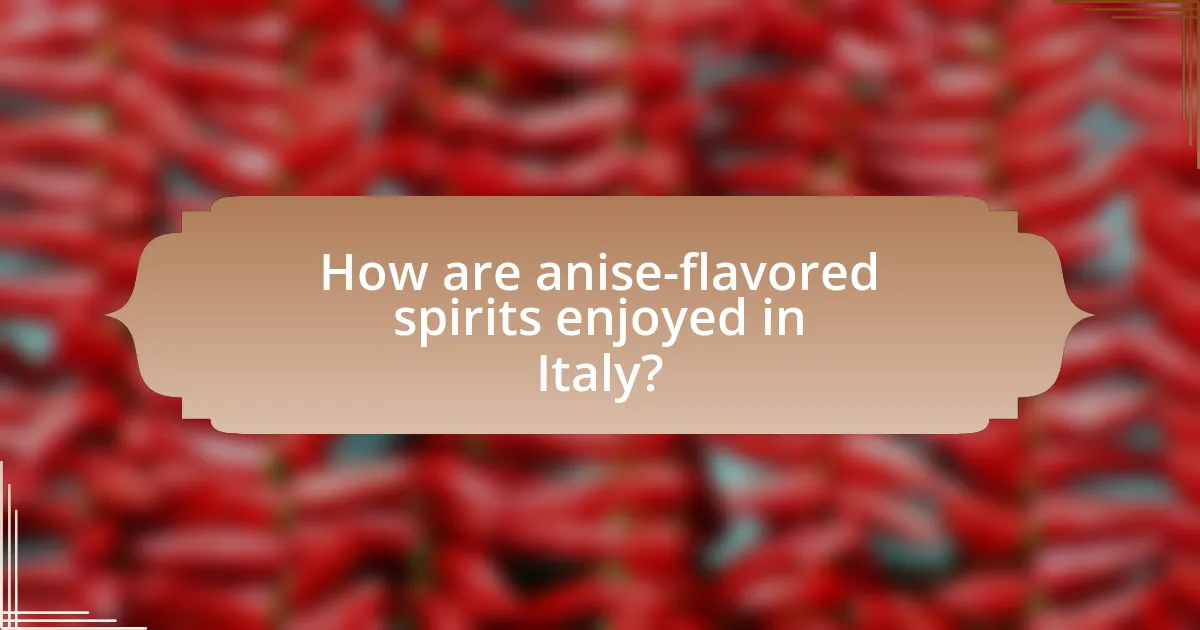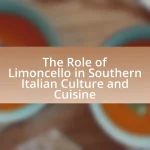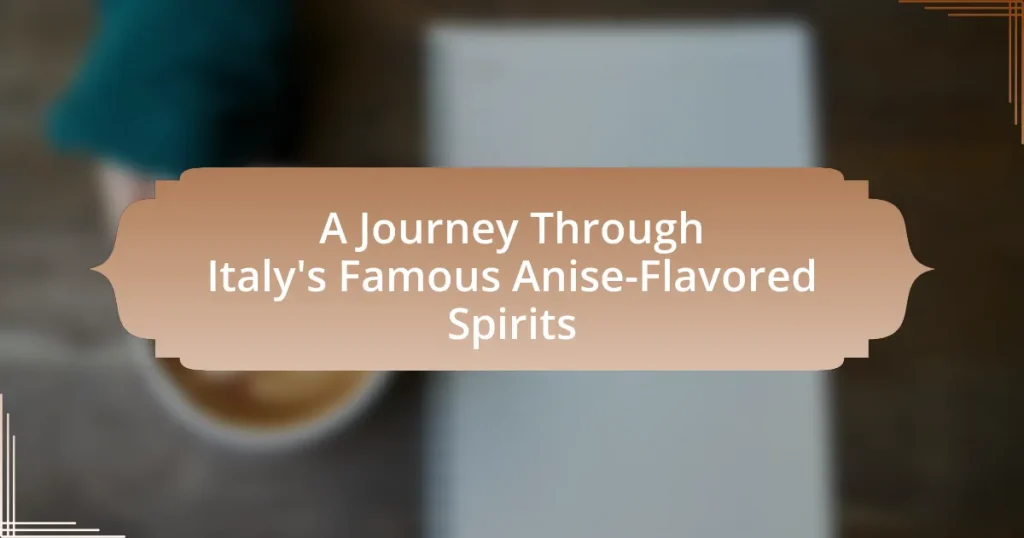Italy’s famous anise-flavored spirits, including Sambuca, Pastis, and Anisette, play a significant role in the country’s culture and cuisine. The article explores the historical origins, production methods, and regional variations of these spirits, highlighting their unique flavor profiles and the ingredients used in their creation. It also examines how cultural traditions shape their consumption, the modern trends influencing their popularity, and the ways in which they are enjoyed during celebrations and rituals. Additionally, the article provides insights into the proper tasting techniques and common mistakes to avoid when serving these spirits, ensuring a comprehensive understanding of Italy’s anise-flavored beverages.
What are Italy’s Famous Anise-Flavored Spirits?
Italy’s famous anise-flavored spirits include Sambuca, Pastis, and Anisette. Sambuca, originating from the central region of Italy, is a sweet, anise-flavored liqueur often served with coffee beans. Pastis, while more commonly associated with France, has Italian variations and is an anise-flavored aperitif. Anisette, a traditional Italian liqueur, is known for its strong anise flavor and is typically enjoyed as a digestif. These spirits are integral to Italian culture and cuisine, often used in cocktails or enjoyed neat.
How did anise-flavored spirits become popular in Italy?
Anise-flavored spirits became popular in Italy primarily due to their association with traditional Italian culture and cuisine. The introduction of anise in the 19th century, particularly through the production of drinks like sambuca and pastis, contributed to their widespread acceptance. These spirits were often consumed as digestifs after meals, enhancing their popularity in social and culinary contexts. The cultural significance of anise-flavored spirits is further evidenced by their incorporation into Italian rituals and celebrations, solidifying their status in Italian drinking customs.
What historical events influenced the production of these spirits?
The production of Italy’s famous anise-flavored spirits has been influenced by several historical events, notably the introduction of anise to Europe in the 1st century AD and the subsequent rise of distillation techniques during the Middle Ages. The cultivation of anise in the Mediterranean region, particularly in Italy, was spurred by trade routes established during the Roman Empire, which facilitated the exchange of spices and herbs. Additionally, the development of alchemical practices in the 12th century led to advancements in distillation, allowing for the creation of more refined spirits. The popularity of these spirits surged during the Renaissance, as they became associated with social gatherings and medicinal uses, further embedding them into Italian culture.
How do cultural traditions shape the consumption of anise-flavored spirits?
Cultural traditions significantly shape the consumption of anise-flavored spirits by influencing the occasions, rituals, and social contexts in which these beverages are enjoyed. In Italy, for example, anise-flavored spirits like Sambuca are often consumed as a digestif after meals, reflecting the Italian tradition of savoring food and drink together. Additionally, these spirits are commonly featured in celebrations and social gatherings, such as weddings and festivals, where they symbolize hospitality and conviviality. Historical practices, such as the use of anise in ancient Roman and Mediterranean cultures for medicinal and culinary purposes, further reinforce the cultural significance of these spirits. The integration of anise-flavored beverages into local customs and culinary practices illustrates how cultural heritage directly influences their consumption patterns.
What are the key characteristics of anise-flavored spirits?
Anise-flavored spirits are characterized by their distinct licorice flavor, which primarily comes from the anise seed. These spirits typically have a clear or slightly cloudy appearance when mixed with water, due to the presence of essential oils that emulsify. The alcohol content usually ranges from 25% to 50% by volume, making them potent yet aromatic. Additionally, anise-flavored spirits often exhibit a sweet taste profile, balancing the herbal notes with sugar or other sweeteners. Popular examples include ouzo from Greece, pastis from France, and sambuca from Italy, each showcasing regional variations in flavor and production methods.
What ingredients are commonly used in the production of these spirits?
Anise-flavored spirits are commonly produced using ingredients such as anise seeds, fennel, and various herbs and spices. Anise seeds provide the primary flavor profile, while fennel adds a sweet, aromatic quality. Additionally, other botanicals like coriander, mint, and citrus peels may be included to enhance the complexity of the spirit. These ingredients are traditionally used in Italian spirits like sambuca and pastis, which rely on the distinct flavor of anise as a key characteristic.
How does the distillation process affect the flavor profile?
The distillation process significantly influences the flavor profile by concentrating desirable aromatic compounds while removing unwanted impurities. During distillation, the heat causes the liquid to vaporize, allowing the separation of components based on their boiling points. This selective evaporation enhances the intensity of flavors, particularly in anise-flavored spirits, where compounds like anethole contribute to the characteristic taste. Research indicates that the distillation method, whether pot still or column still, can further alter the flavor by affecting the retention of specific volatile compounds, thus shaping the final product’s aromatic complexity.

What are the most popular types of anise-flavored spirits in Italy?
The most popular types of anise-flavored spirits in Italy are Sambuca, Pastis, and Anisette. Sambuca, a sweet, anise-flavored liqueur, is often served with coffee or as a digestif. Pastis, while originally from France, has gained popularity in Italy and is known for its strong anise flavor and is typically diluted with water. Anisette, a sweet liqueur with a distinct anise taste, is commonly enjoyed as an after-dinner drink. These spirits are integral to Italian culture and are frequently used in various cocktails and culinary applications.
What distinguishes each type of anise-flavored spirit?
Anise-flavored spirits are distinguished by their unique production methods, flavor profiles, and regional origins. For example, Sambuca, originating from Italy, is characterized by its sweet flavor and is often served with coffee beans, while Ouzo from Greece has a more herbal taste and is typically enjoyed with meze. Pastis, a French spirit, is known for its strong licorice flavor and is diluted with water before consumption, resulting in a milky appearance. Each spirit’s distinctiveness is rooted in its ingredients and traditional recipes, reflecting the cultural heritage of its region.
How does the production method vary among different types?
The production method of Italy’s famous anise-flavored spirits varies significantly among different types, primarily influenced by the base ingredients and distillation techniques used. For example, traditional absinthe production involves macerating herbs, including anise, in alcohol, followed by distillation, while sambuca typically uses a sugar syrup combined with anise oil and is distilled to achieve a sweeter flavor profile. Additionally, the use of natural versus artificial flavorings can further differentiate the production methods, with artisanal brands often emphasizing natural ingredients and traditional distillation processes to enhance authenticity and flavor complexity.
What are the unique flavor notes of each spirit?
The unique flavor notes of Italy’s famous anise-flavored spirits include distinct characteristics for each type. For example, Sambuca features a strong anise flavor complemented by hints of sweetness and a touch of herbal complexity. Ouzo, while also anise-forward, presents a more pronounced licorice taste with citrus undertones and a slightly oily texture. Pastis, on the other hand, offers a blend of anise and herbal flavors, often with a subtle sweetness and a refreshing finish. Each spirit’s flavor profile is shaped by its ingredients and production methods, ensuring a unique tasting experience that reflects regional traditions.
What role do regional variations play in Italy’s anise-flavored spirits?
Regional variations significantly influence Italy’s anise-flavored spirits by determining the specific ingredients, production methods, and flavor profiles unique to each area. For instance, in Sardinia, the local spirit known as Mirto incorporates myrtle alongside anise, creating a distinct taste that reflects the island’s botanical diversity. In contrast, in the southern regions like Calabria, the use of locally sourced anise seeds results in a more robust flavor, exemplified by the popular liqueur known as Liquore di Anice. These regional differences not only highlight the cultural heritage and agricultural practices of each area but also contribute to the overall diversity of Italy’s anise-flavored spirits, making them a reflection of local traditions and preferences.
Which regions are known for their distinct anise-flavored spirits?
Regions known for their distinct anise-flavored spirits include Italy, France, Spain, and Greece. In Italy, regions such as Sicily and Sardinia are famous for their anise-based liqueurs like Sambuca and Mirto. France is recognized for pastis, particularly in the Provence region. Spain produces anise-flavored spirits like Orujo in Galicia, while Greece is known for its ouzo, especially in the Aegean islands. Each of these regions has a rich tradition of producing these spirits, often using local ingredients and methods that reflect their cultural heritage.
How do local ingredients influence the taste and quality?
Local ingredients significantly enhance the taste and quality of anise-flavored spirits by providing unique flavors and aromas that reflect the region’s terroir. For instance, the use of locally sourced anise seeds, which vary in flavor profile depending on the soil and climate conditions, contributes to the distinct character of each spirit. Additionally, local herbs and botanicals, such as fennel or mint, can be incorporated, further enriching the complexity and depth of the final product. This regional specificity not only influences the sensory experience but also supports local agriculture and traditions, ensuring that the spirits maintain authenticity and cultural significance.

How are anise-flavored spirits enjoyed in Italy?
Anise-flavored spirits in Italy are typically enjoyed as digestifs, consumed after meals to aid digestion. These spirits, such as Sambuca and Pastis, are often served neat, on the rocks, or with coffee, enhancing their aromatic qualities. In Italian culture, it is common to accompany these drinks with a few coffee beans or to mix them with water, which causes a milky transformation, highlighting their unique flavors. This tradition reflects the Italian appreciation for the balance of taste and the ritual of savoring spirits in social settings.
What are the traditional ways to serve anise-flavored spirits?
Anise-flavored spirits are traditionally served in various ways, including neat, with water, or as part of cocktails. Serving them neat allows the drinker to appreciate the full flavor profile, while adding water can enhance the aroma and taste, a common practice in countries like Italy and France. In Italy, anise-flavored spirits such as Sambuca are often served with coffee or as a digestif after meals, highlighting their role in culinary traditions.
What food pairings enhance the experience of these spirits?
Food pairings that enhance the experience of Italy’s famous anise-flavored spirits include seafood, particularly grilled fish and shellfish, as well as desserts like biscotti and panna cotta. Seafood complements the herbal notes of anise, creating a balanced flavor profile, while sweet desserts provide a contrasting taste that highlights the spirit’s complexity. Historical practices in Italian cuisine often feature these pairings, as they have been traditionally enjoyed together, enhancing the overall tasting experience.
How do Italians incorporate these spirits into celebrations and rituals?
Italians incorporate anise-flavored spirits, such as sambuca and pastis, into celebrations and rituals by serving them as traditional digestifs after meals and during festive occasions. These spirits are often enjoyed in social settings, where sambuca is commonly served with coffee or as a shot with roasted coffee beans, symbolizing hospitality and warmth. Additionally, during religious festivals and family gatherings, these spirits are used in toasts and rituals, reflecting cultural heritage and communal bonding. The historical significance of these practices is evident in regional customs, where specific anise spirits are tied to local celebrations, enhancing the festive atmosphere and reinforcing social connections.
What modern trends are emerging in the consumption of anise-flavored spirits?
Modern trends in the consumption of anise-flavored spirits include a growing interest in craft distillation and innovative cocktail applications. Consumers are increasingly seeking artisanal brands that emphasize quality ingredients and traditional production methods, reflecting a broader trend towards premiumization in the spirits market. Additionally, the rise of mixology has led to the incorporation of anise-flavored spirits in creative cocktails, appealing to younger demographics who favor unique flavor profiles. According to a report by IWSR, the global market for anise-flavored spirits is projected to grow, driven by these evolving consumer preferences and the resurgence of classic cocktails.
How are craft distilleries changing the landscape of anise-flavored spirits?
Craft distilleries are transforming the landscape of anise-flavored spirits by introducing innovative production methods and unique flavor profiles. These small-scale producers often emphasize artisanal techniques, allowing for greater experimentation with botanicals and local ingredients, which results in diverse interpretations of traditional anise spirits. For instance, craft distilleries in Italy are increasingly incorporating regional herbs and spices, enhancing the complexity and appeal of their offerings. This shift has led to a resurgence in consumer interest, as evidenced by a 2022 report from the Distilled Spirits Council, which noted a 15% increase in sales of craft anise-flavored spirits over the previous year.
What innovations are being introduced in flavor and presentation?
Innovations in flavor and presentation of Italy’s famous anise-flavored spirits include the introduction of unique botanical blends and modern serving techniques. Distillers are experimenting with additional herbs and spices, such as citrus peels and exotic botanicals, to create complex flavor profiles that enhance the traditional anise taste. Furthermore, presentation innovations involve the use of artisanal glassware and creative garnishing, such as edible flowers or flavored ice cubes, which elevate the drinking experience. These advancements reflect a growing trend towards personalization and aesthetic appeal in the beverage industry, catering to consumer preferences for both taste and visual presentation.
What tips can enhance the enjoyment of Italy’s anise-flavored spirits?
To enhance the enjoyment of Italy’s anise-flavored spirits, serve them chilled or over ice to accentuate their refreshing qualities. Chilling these spirits, such as Sambuca or Pastis, helps to mellow their strong flavors and brings out the aromatic notes. Additionally, pairing them with complementary foods, like dark chocolate or coffee, can elevate the tasting experience by balancing the sweetness and herbal characteristics. Historically, Italians often enjoy these spirits as a digestif after meals, which can further enhance their appreciation by allowing the flavors to linger and settle after dining.
How should one properly taste and appreciate these spirits?
To properly taste and appreciate Italy’s famous anise-flavored spirits, one should follow a systematic approach that includes observing, smelling, tasting, and reflecting. First, observe the spirit’s color and clarity in a suitable glass, which can indicate its quality and age. Next, swirl the glass gently to release the aromas, then take a moment to inhale the scent, identifying the distinct anise and herbal notes.
When tasting, take a small sip and let it coat your palate, paying attention to the flavors that develop, such as sweetness, bitterness, or herbal complexity. It is essential to note the finish, which can reveal additional layers of flavor. Finally, reflect on the overall experience, considering how the spirit’s characteristics align with its traditional production methods and regional origins, enhancing appreciation. This methodical approach is supported by tasting guidelines from experts in the field, emphasizing sensory engagement for a deeper understanding of the spirit’s nuances.
What common mistakes should be avoided when serving anise-flavored spirits?
Common mistakes to avoid when serving anise-flavored spirits include serving them at the wrong temperature, neglecting proper glassware, and failing to pair them with suitable food. Serving anise-flavored spirits, such as ouzo or sambuca, at room temperature can overpower their delicate flavors; they are best enjoyed chilled or with ice. Using inappropriate glassware, like standard tumblers instead of specific anise glasses, can diminish the drinking experience, as the right glass enhances aroma and presentation. Additionally, pairing these spirits with incompatible foods, such as overly spicy or rich dishes, can clash with their unique flavor profiles, leading to an unsatisfactory tasting experience.










